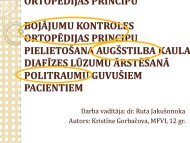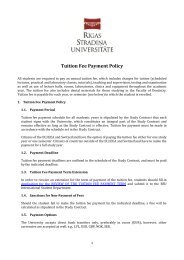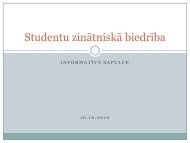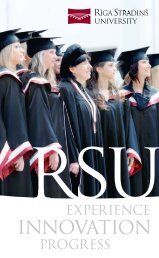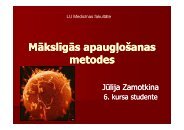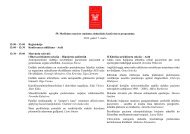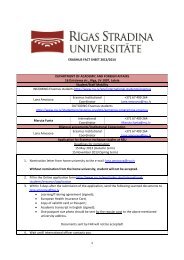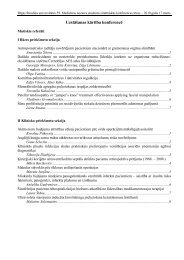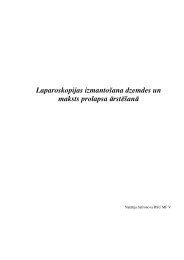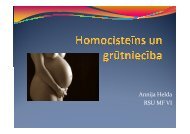History of Latvia: a Brief Survey
History of Latvia: a Brief Survey
History of Latvia: a Brief Survey
- No tags were found...
You also want an ePaper? Increase the reach of your titles
YUMPU automatically turns print PDFs into web optimized ePapers that Google loves.
Krišjānis Valdemārs (1825-1891), main ideologue <strong>of</strong>the New <strong>Latvia</strong>n movement and the most prominentsocial and political figure <strong>of</strong> the time; publicist,editor <strong>of</strong> the Peterburgas Awizes. Valdemārs’ ideashave been very influential in the development <strong>of</strong>national romanticism and the history <strong>of</strong> <strong>Latvia</strong>npublic opinion. He also played a large role in the thedevelopment <strong>of</strong> <strong>Latvia</strong>n seafaring.Barquentine Anna Wictoria, built in 1878 in Ainaži. The firsttwo <strong>Latvia</strong>n peasant-built ships were built in 1857: the PeterS<strong>of</strong>ia in Mangaļi and the Victoria in Pabaži.The first newspapers printed in the<strong>Latvia</strong>n language from the 1800s:Latweeschu Awizes (‘<strong>Latvia</strong>n Newspaper’,est. 1824), Peterburgas Awizes(‘St Petersburg Newspaper’, est. 1862) andliterary magazine Austrums (est. 1885).Industry spread quickly in the late 1700s, bringing with it a major population growth. Vidzemeand Kurzeme became Russia’s most developed provinces, but conditions for peasantsbecame worse: they were poor, and noblemen’s power was unlimited after the annexationto the Russian Empire. Despite this, however, political preconditions and the developingeconomy caused serfdom to be abolished in Vidzeme in 1817, in Kurzeme in 1819, and inLatgale in 1861.Krišjānis Barons (1835-1923), promoter<strong>of</strong> the <strong>Latvia</strong>n national awakening <strong>of</strong> the19th century; collector, compiler andresearcher <strong>of</strong> <strong>Latvia</strong>n folksongs (dainas)— some dating back hundreds <strong>of</strong> years;editor <strong>of</strong> the newspaper PeterburgasAwizes.18In the mid-19th century, with the rise <strong>of</strong> national consciousness throughout Europe, ethnic<strong>Latvia</strong>ns experienced a powerful ‘awakening’ <strong>of</strong> national identity. The first newspapers in the<strong>Latvia</strong>n language were printed, and active cultural development took place. The first <strong>Latvia</strong>nNational Song Festival was held in 1873 — the beginning <strong>of</strong> a long-standing tradition withstrong national overtones.The latter half <strong>of</strong> the 19th century marked a period <strong>of</strong> national rebirth — the most activemembers <strong>of</strong> <strong>Latvia</strong>n social and cultural life, the so-called New-<strong>Latvia</strong>ns (jaunlatvieši),demanded the same rights long-enjoyed by other nations. Starting from 1862, the weekly<strong>Latvia</strong>n language newspaper Peterburgas Awizes parodied and criticised Baltic German claimsto cultural and political superiority.



